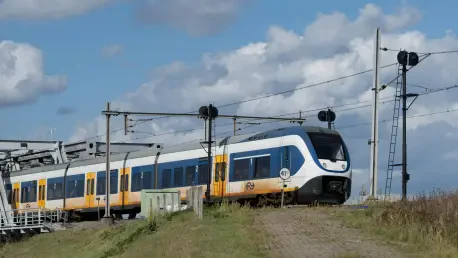Imagine a rail network where trains operate autonomously, stations manage crowds intelligently, and infrastructure issues are detected and resolved in real time. This vision is no longer a distant dream but a tangible reality with the advent of 5G technology in railway communication. As rail systems worldwide grapple with aging infrastructure and rising demands for safety and efficiency, 5G emerges as a game-changer, promising to transform how rail operations are conducted. This review delves into the groundbreaking deployment of 5G in rail communication, spotlighting its features, real-world applications, and the challenges that lie ahead in modernizing one of the oldest modes of transport.
Understanding 5G in the Context of Rail Communication
The integration of 5G technology into railway systems marks a pivotal shift from traditional communication frameworks to a more robust, future-ready standard. Unlike legacy systems such as GSM-R, which have supported rail operations for decades but struggle with modern data demands, 5G introduces the Future Railway Mobile Communication System (FRMCS). This next-generation platform is designed to handle the complexities of digitalized rail networks, ensuring seamless connectivity for mission-critical tasks.
At its core, 5G offers unprecedented speed and bandwidth, enabling rail operators to manage vast amounts of data with minimal delay. This capability is essential for enhancing safety protocols and operational efficiency across sprawling rail networks. The push toward modernization is evident in collaborations among industry leaders to replace outdated systems, reflecting a broader trend of digital transformation within transportation sectors.
The significance of this shift cannot be overstated, as rail communication directly impacts passenger safety and service reliability. With 5G, the industry is poised to address long-standing limitations, paving the way for smarter, more responsive rail ecosystems. This review aims to unpack the technical advancements and practical implications of this technology in reshaping rail operations.
Technical Innovations and Performance of 5G in Rail Systems
Ultra-Low Latency for Critical Operations
One of the standout features of 5G in railway communication is its ultra-low latency, a critical factor for safety-intensive applications. Real-time data transmission ensures that automated train control systems can react instantly to changing conditions, reducing the risk of accidents and improving response times during emergencies. This performance edge is vital for maintaining high safety standards in dynamic rail environments.
Beyond safety, low latency supports precise coordination between trains and control centers, enabling smoother scheduling and reducing delays. For instance, split-second updates on track conditions or obstacles can be relayed without interruption, ensuring that decisions are based on the most current information. Such responsiveness is a cornerstone of modern rail operations, where even minor delays can cascade into significant disruptions.
The impact of this feature extends to the passenger experience as well, with more reliable services and fewer unexpected interruptions. As rail networks adopt 5G, the ability to handle real-time demands becomes a benchmark for operational excellence, setting a new standard for safety and efficiency in transportation.
Resilience Through Self-Healing and Failover Systems
Another critical advancement in 5G rail communication is its inherent resilience, achieved through self-healing networks and failover mechanisms. These systems are engineered to detect and address disruptions automatically, ensuring continuous service even during technical failures or external interference. Such reliability is indispensable in mission-critical settings where downtime can have severe consequences.
This built-in robustness means that rail operations can maintain connectivity under challenging conditions, such as network congestion or hardware malfunctions. By rerouting data through alternative pathways or activating backup systems, 5G networks minimize the risk of service interruptions, preserving the integrity of essential communications. This capability is especially crucial in remote or high-traffic rail corridors where consistent performance is non-negotiable.
The emphasis on resilience reflects a strategic focus on operational continuity, allowing rail operators to prioritize safety and service quality without the constant threat of network failures. As deployments expand, these features will likely become a defining aspect of 5G’s value proposition in transforming rail infrastructure.
Milestones in 5G Rail Technology Deployment
Recent progress in 5G railway communication has been marked by significant achievements, most notably the world’s first commercial 5G radio network operating in the 1900 MHz (n101) band. Deployed by Nokia in collaboration with Deutsche Bahn (DB) at a digital test field in Germany’s Ore Mountains, this initiative showcases the potential of 5G Standalone (SA) core technology to meet stringent safety and capacity needs. It represents a landmark step toward adopting FRMCS as the global standard.
Parallel efforts across Europe underscore a regional commitment to this technological shift. Nokia’s partnership with ProRail in the Netherlands, spanning from this year to 2027, focuses on modernizing existing GSM-R infrastructure with cloud-native solutions. This project aims to streamline the transition to FRMCS, reducing operational costs while enhancing network reliability across national rail systems.
These developments signal a unified push among European rail operators to embrace digital solutions that address both current and future needs. The successful implementation of 5G in test environments highlights its readiness for broader application, setting a precedent for other regions to follow in upgrading their rail communication frameworks.
Practical Implementations and Benefits in Rail Operations
The real-world applications of 5G in rail systems are already demonstrating transformative potential, particularly in automating train operations. At DB’s test field in Germany, 5G enables precise control and monitoring of trains, reducing human error and optimizing travel schedules. This level of automation is a critical component in achieving higher efficiency and safety standards across rail networks.
Intelligent station management is another area where 5G shines, facilitating real-time crowd control and resource allocation through connected sensors and data analytics. Stations equipped with this technology can dynamically adjust to passenger flows, improving both safety and comfort. Such innovations contribute to a more seamless travel experience, addressing common pain points in busy transit hubs.
Additionally, 5G enhances infrastructure monitoring by supporting continuous data feeds from sensors embedded along tracks and in equipment. This allows for predictive maintenance, where potential issues are identified and resolved before they escalate, minimizing service disruptions. These use cases collectively illustrate how 5G is redefining the operational landscape of rail systems with practical, impactful solutions.
Barriers to Widespread 5G Adoption in Rail Networks
Despite its promise, the adoption of 5G in railway communication faces several hurdles that must be addressed for large-scale implementation. A primary challenge is the technical complexity of transitioning from GSM-R to FRMCS, which requires extensive retrofitting of existing infrastructure. This process is not only time-consuming but also demands significant expertise to ensure compatibility and performance.
Regulatory constraints around spectrum allocation further complicate the rollout, as securing dedicated frequencies for rail-specific 5G networks involves navigating complex policy landscapes. Additionally, the high financial cost of upgrading infrastructure poses a barrier, particularly for smaller operators with limited budgets. These economic considerations often delay modernization efforts, even in regions with strong digital ambitions.
Efforts by industry pioneers like Nokia and DB to mitigate these challenges are underway, focusing on scalable solutions and collaborative frameworks. Nevertheless, overcoming these obstacles requires coordinated action among stakeholders, including governments and private entities, to align on standards and funding mechanisms that facilitate a smoother migration path.
Looking Ahead: The Future of 5G in Rail Communication
The trajectory of 5G in rail communication points toward expansive growth, with anticipated rollouts of FRMCS across more regions in the coming years. Emerging technological breakthroughs, such as enhanced network slicing for prioritized data traffic, are expected to further refine 5G’s applicability in rail contexts. These advancements will likely bolster the capacity for automation and real-time decision-making in complex rail environments.
Sustainability is another focal point for future developments, as 5G networks are designed to optimize energy use and reduce the carbon footprint of rail operations. This aligns with global priorities for greener transportation systems, positioning 5G as a key enabler of eco-friendly innovation. The potential for these systems to integrate with other smart technologies also opens new avenues for comprehensive rail modernization.
Europe, with its proactive stance on digital transformation, stands to lead the charge in establishing 5G as a cornerstone of modern rail infrastructure. As pilot projects evolve into nationwide implementations, the lessons learned will inform global strategies, potentially accelerating adoption in other parts of the world. This forward-looking perspective underscores the strategic importance of continued investment in 5G rail technology.
Final Reflections on 5G Rail Communication
Reflecting on the journey of 5G in railway communication, the collaboration between Nokia and Deutsche Bahn stands as a defining moment, having introduced the first commercial 5G network tailored for rail operations. This milestone, alongside parallel initiatives in the Netherlands with ProRail, highlights the technology’s capacity to outperform legacy systems through low latency and resilient network design. The practical benefits observed in automated operations and infrastructure monitoring further cement 5G’s role in enhancing rail safety and efficiency.
Moving forward, the focus shifts to actionable strategies for overcoming adoption challenges, such as fostering public-private partnerships to address funding gaps and streamline regulatory processes. Industry stakeholders are encouraged to prioritize standardized migration plans to FRMCS, ensuring interoperability across borders. By investing in scalable pilot projects, rail operators can build confidence in 5G’s long-term value, setting the stage for transformative change in global rail networks.









